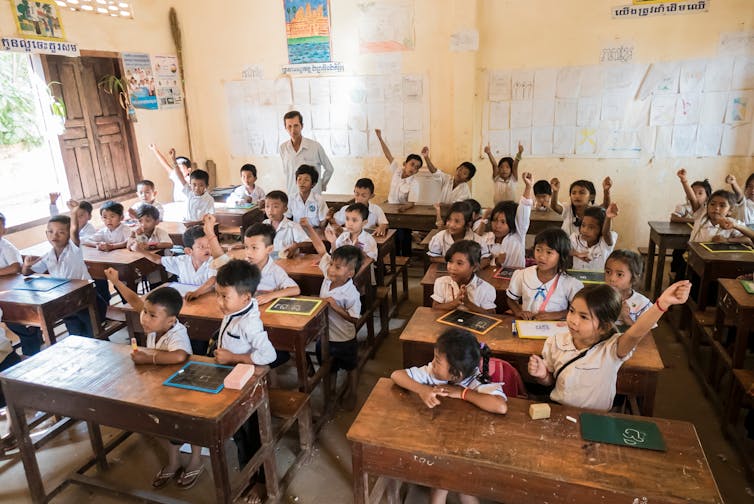1.2 billion young people will need a job in the next 10 years. The World Bank is trying to help them find one
- Written by Melissa Conley Tyler, Honorary Fellow, Asia Institute, The University of Melbourne

World Bank president Ajay Banga is in Canberra this week. It’s the first time a World Bank president has visited Australia in seven years[1].
Why is he here? It goes to the heart of the World Bank’s purpose.
Set up after second world war to fund reconstruction, the World Bank’s modern mission is to create a world free of poverty on a liveable planet[2]. It has 189 member countries [3].
What does the World Bank do?
The bank funds projects in developing countries through a mix of grants and concessional loans[4] that countries pay back. Last year it provided A$136 billion[5] to 75 nations in grants and loans.
One of its funds, the International Development Agency[6], supports projects in 76 of the world’s least developed countries.
Through this work 36 countries have graduated from least developed to middle income status, and many, like South Korea, have now become donors themselves.
That means a big part of the World Bank president’s job is securing funding. The International Development Agency fund is currently in a three-yearly “replenishment” round[7] where it seeks contributions from donor countries.
The World Bank has set an ambitious goal[8] of raising about A$44.2 billion from donors who will announce their pledges[9] at the bank’s December meeting.
If it can convince donors to reach this figure, it can leverage[10] this into a A$149.9 billion fund by using its AAA credit rating to borrow further in international capital markets[11].
Why Australia’s role is important
From the bank’s perspective, Australia plays a significant[12] role. It is a particularly important donor in the Pacific, for example, donating money for a fund[13] which has contributed to a 50% increase in the World Bank’s Pacific-based staff and a seven-fold increase in its projects in the region.
This supports more than 95 projects[14] on agriculture, digital development, education, fisheries, health, renewable energy, transport and employment.
Compared to other countries, Australia gives a relatively low proportion[16] of its development funding through multilateral bodies like the World Bank – directing more of its funding through bilateral channels.
The World Bank needs a coalition of countries[17] including Australia to make big pledges to fund the bank’s work.
Who is Ajay Banga?
Banga is not your typical appointment, having being born and grown up in a developing country and taking on the presidency which is traditionally held by an American. He is an American citizen.
He comes from business, having previously[18] been president and CEO of Mastercard, as well as roles with PepsiCo, Citigroup and Nestlé in India. He was chairman of the International Chamber of Commerce.
He is known[19] for his work at Mastercard launching the Centre for Inclusive Growth, which advances equitable and sustainable economic growth and financial inclusion around the world.
He also stands out compared to his predecessor on climate change. He added the words “on a livable planet” to the World Bank’s mission.
As well as visiting Australia on this trip, he has been to Fiji and Tuvalu where he saw the devastation caused by climate change[20] first-hand.
With this background – and access to all the World Bank’s facts and figures – he has a sense of the lived reality of people’s lives and the gravest dangers to this planet.
Banga’s top priorities
This week the president said “jobs[21]” was his top priority.
In little more than a decade, 1.2 billion young people worldwide will be of job-seeking age, according to figures he presented to think tank, the Lowy Institute[22]. With current forecasts of 400-500 million jobs likely to be created, there’s a huge gap.
That means there’s an urgent need to create jobs so these young people don’t become a migration, drugs or conflict problem.
Banga said we need “governments, philanthropies and multilateral development banks working together” to produce more jobs.
It’s a reminder why it is so important for a developed country like Australia to invest in development aid to create a stable, prosperous region and wider world.
Dealing with global poverty is preventive. It’s cheaper and easier to invest in electricity, health care and education now than with the costs of instability or chaos later.
The good news is the world’s investments in development have led to a sharp reduction in global poverty since 1981[23]. Banga’s message to Australia is
Ultimately the World Bank is an instrument that reflects the ambition of those on whose generosity it relies, and the progress we aspire to achieve demands more.
References
- ^ seven years (www.smh.com.au)
- ^ world free of poverty on a liveable planet (www.worldbank.org)
- ^ 189 member countries (www.worldbank.org)
- ^ grants and concessional loans (www.cgdev.org)
- ^ A$136 billion (www.worldbank.org)
- ^ International Development Agency (thedocs.worldbank.org)
- ^ “replenishment” round (devpolicy.org)
- ^ ambitious goal (www.cgdev.org)
- ^ announce their pledges (www.worldbank.org)
- ^ leverage (www.cgdev.org)
- ^ international capital markets (www.cgdev.org)
- ^ Australia plays a significant (www.worldbank.org)
- ^ for a fund (www.worldbank.org)
- ^ more than 95 projects (www.worldbank.org)
- ^ Agent Wolf/Shutterstock (www.shutterstock.com)
- ^ relatively low proportion (devpolicy.org)
- ^ coalition of countries (www.cgdev.org)
- ^ previously (www.forbesindia.com)
- ^ known (www.worldbank.org)
- ^ devastation caused by climate change (www.sbs.com.au)
- ^ jobs (www.smh.com.au)
- ^ the Lowy Institute (www.lowyinstitute.org)
- ^ since 1981 (www.worldbank.org)
Authors: Melissa Conley Tyler, Honorary Fellow, Asia Institute, The University of Melbourne







